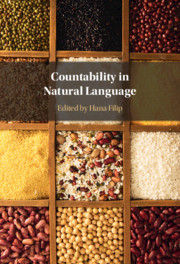Book contents
- Countability in Natural Language
- Countability in Natural Language
- Copyright page
- Contents
- Contributors
- Preface
- Introduction
- 1 Proportional Many/Much and Most
- 2 Quantity Systems and the Count/Mass Distinction
- 3 Counting Aggregates, Groups and Kinds: Countability from the Perspective of a Morphologically Complex Language
- 4 Individuating Matter over Time
- 5 Reduplication as Summation
- 6 Iceberg Semantics for Count Nouns and Mass Nouns: How Mass Counts
- 7 Indexical Inference: Counting and Measuring in Context
- 8 Counting and Measuring and Approximation
- 9 The Count/Mass Distinction for Granular Nouns
- Index
- References
3 - Counting Aggregates, Groups and Kinds: Countability from the Perspective of a Morphologically Complex Language
Published online by Cambridge University Press: 11 June 2021
- Countability in Natural Language
- Countability in Natural Language
- Copyright page
- Contents
- Contributors
- Preface
- Introduction
- 1 Proportional Many/Much and Most
- 2 Quantity Systems and the Count/Mass Distinction
- 3 Counting Aggregates, Groups and Kinds: Countability from the Perspective of a Morphologically Complex Language
- 4 Individuating Matter over Time
- 5 Reduplication as Summation
- 6 Iceberg Semantics for Count Nouns and Mass Nouns: How Mass Counts
- 7 Indexical Inference: Counting and Measuring in Context
- 8 Counting and Measuring and Approximation
- 9 The Count/Mass Distinction for Granular Nouns
- Index
- References
Summary
Thischapter focuses on data from Czech, specifically, derived aggregates and complex numerals. Derived aggregates such as list-í (leaf- í- NOM.SG, ‘foliage’) are derived from a count noun (e.g., list) and the suffix -í. Furthermore, aggregates derived with -í are non-count. Grimm and Dočekal discuss three types of complex numerals that are also morphologically derived: derived group numerals, complex numerals for aggregates, and taxonomic numerals. As well as using these data to bolster the support for a view in which aggregates are a distinct kind of non-countable entity from substances, the authorsargue the complexity of the morphosyntactic resources a language can limit the extent to which nouns in that language are mass/count flexible. These data are then modeled in a neo-Krifkan framework, enriched with mereotopology that accounts for taxonomic and group numeral constructions, the sense in which derived aggregates denote clustered individuals (individuals formed of parts that stand in relatedness relations to one another), and why the counting of derived aggregates in Czech is only possible with complex numerals for aggregates.
- Type
- Chapter
- Information
- Countability in Natural Language , pp. 85 - 120Publisher: Cambridge University PressPrint publication year: 2021
References
- 2
- Cited by

